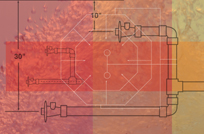Water Under Pressure

Of all the concepts of hydraulic-system design, there are few that have more importance than the correlation between water flow (that is, capacity expressed as gallons per minute) and line velocity (the speed at which the water travels).
As water travels through a pipe, its increase in speed (that is, its line velocity) results in an increase in resistance (expressed as feet of head) and in a reduction of end pressure, which is measured in pounds per square inch (psi). In other words, an increase in friction losses and a drop in pressure is the result of increased water velocity at a given flow.
If that makes sense to you without further explanation, then you know much of what you need to know when it comes to selecting pipes and fittings and setting up a watershape’s plumbing system. If it doesn’t, this article will cover the basics – from selecting pipes and sizing lines to plumbing in downsized manifolds and setting up loops – all with a goal of [more]










